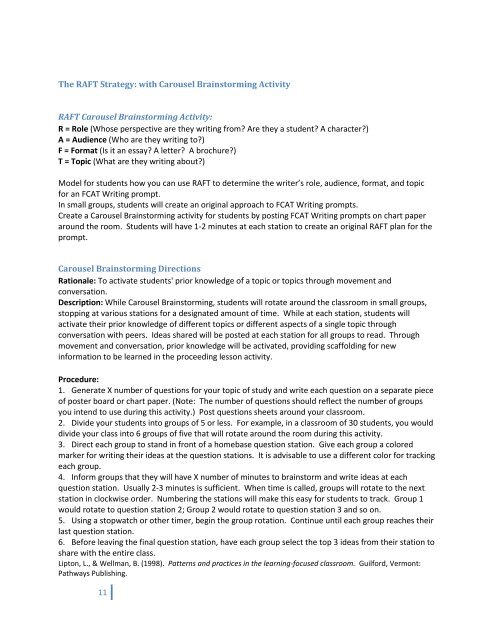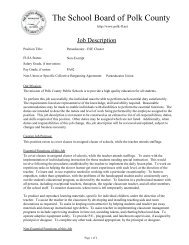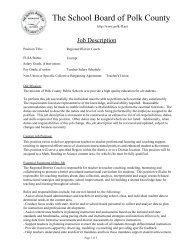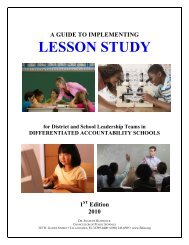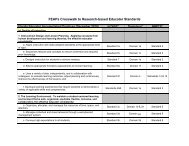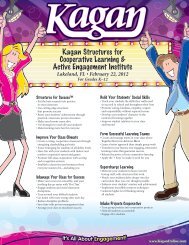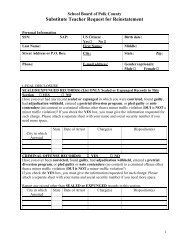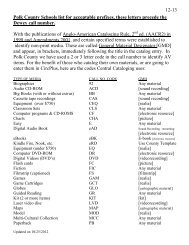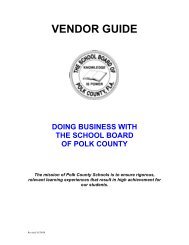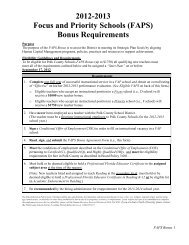Thirty Days to Unlock FCAT Writing Success - Polk County School ...
Thirty Days to Unlock FCAT Writing Success - Polk County School ...
Thirty Days to Unlock FCAT Writing Success - Polk County School ...
You also want an ePaper? Increase the reach of your titles
YUMPU automatically turns print PDFs into web optimized ePapers that Google loves.
The RAFT Strategy: with Carousel Brains<strong>to</strong>rming Activity<br />
RAFT Carousel Brains<strong>to</strong>rming Activity:<br />
R = Role (Whose perspective are they writing from? Are they a student? A character?)<br />
A = Audience (Who are they writing <strong>to</strong>?)<br />
F = Format (Is it an essay? A letter? A brochure?)<br />
T = Topic (What are they writing about?)<br />
Model for students how you can use RAFT <strong>to</strong> determine the writer’s role, audience, format, and <strong>to</strong>pic<br />
for an <strong>FCAT</strong> <strong>Writing</strong> prompt.<br />
In small groups, students will create an original approach <strong>to</strong> <strong>FCAT</strong> <strong>Writing</strong> prompts.<br />
Create a Carousel Brains<strong>to</strong>rming activity for students by posting <strong>FCAT</strong> <strong>Writing</strong> prompts on chart paper<br />
around the room. Students will have 1-2 minutes at each station <strong>to</strong> create an original RAFT plan for the<br />
prompt.<br />
Carousel Brains<strong>to</strong>rming Directions<br />
Rationale: To activate students' prior knowledge of a <strong>to</strong>pic or <strong>to</strong>pics through movement and<br />
conversation.<br />
Description: While Carousel Brains<strong>to</strong>rming, students will rotate around the classroom in small groups,<br />
s<strong>to</strong>pping at various stations for a designated amount of time. While at each station, students will<br />
activate their prior knowledge of different <strong>to</strong>pics or different aspects of a single <strong>to</strong>pic through<br />
conversation with peers. Ideas shared will be posted at each station for all groups <strong>to</strong> read. Through<br />
movement and conversation, prior knowledge will be activated, providing scaffolding for new<br />
information <strong>to</strong> be learned in the proceeding lesson activity.<br />
Procedure:<br />
1. Generate X number of questions for your <strong>to</strong>pic of study and write each question on a separate piece<br />
of poster board or chart paper. (Note: The number of questions should reflect the number of groups<br />
you intend <strong>to</strong> use during this activity.) Post questions sheets around your classroom.<br />
2. Divide your students in<strong>to</strong> groups of 5 or less. For example, in a classroom of 30 students, you would<br />
divide your class in<strong>to</strong> 6 groups of five that will rotate around the room during this activity.<br />
3. Direct each group <strong>to</strong> stand in front of a homebase question station. Give each group a colored<br />
marker for writing their ideas at the question stations. It is advisable <strong>to</strong> use a different color for tracking<br />
each group.<br />
4. Inform groups that they will have X number of minutes <strong>to</strong> brains<strong>to</strong>rm and write ideas at each<br />
question station. Usually 2-3 minutes is sufficient. When time is called, groups will rotate <strong>to</strong> the next<br />
station in clockwise order. Numbering the stations will make this easy for students <strong>to</strong> track. Group 1<br />
would rotate <strong>to</strong> question station 2; Group 2 would rotate <strong>to</strong> question station 3 and so on.<br />
5. Using a s<strong>to</strong>pwatch or other timer, begin the group rotation. Continue until each group reaches their<br />
last question station.<br />
6. Before leaving the final question station, have each group select the <strong>to</strong>p 3 ideas from their station <strong>to</strong><br />
share with the entire class.<br />
Lip<strong>to</strong>n, L., & Wellman, B. (1998). Patterns and practices in the learning-focused classroom. Guilford, Vermont:<br />
Pathways Publishing.<br />
11


